Infectious Disease Management Plan for Ebola Outbreak in Delhi, India
VerifiedAdded on 2022/11/22
|11
|1983
|64
Report
AI Summary
This report presents a comprehensive disaster management plan for an Ebola outbreak, specifically in the context of a hypothetical scenario in Delhi, India. The report begins with an introduction to Ebola, its origins, transmission, and symptoms, followed by a discussion of the scope of the outbreak, considering the large gatherings that occur in India, particularly during Independence Day celebrations. The purpose and executive summary outline the report's aims, including creating awareness, providing guidelines for prevention and response, and assessing preparedness. The report details management resources, including strategies for coordination, surveillance, case management, and community engagement. It also identifies factors impacting the disaster response plan, such as host and environmental factors. A plan layout addresses psychological stressors, encompassing repatriation, rehabilitation, and control measures. The report concludes with recommendations for disease control and awareness, emphasizing the importance of border control and vigilant disease scrutiny.
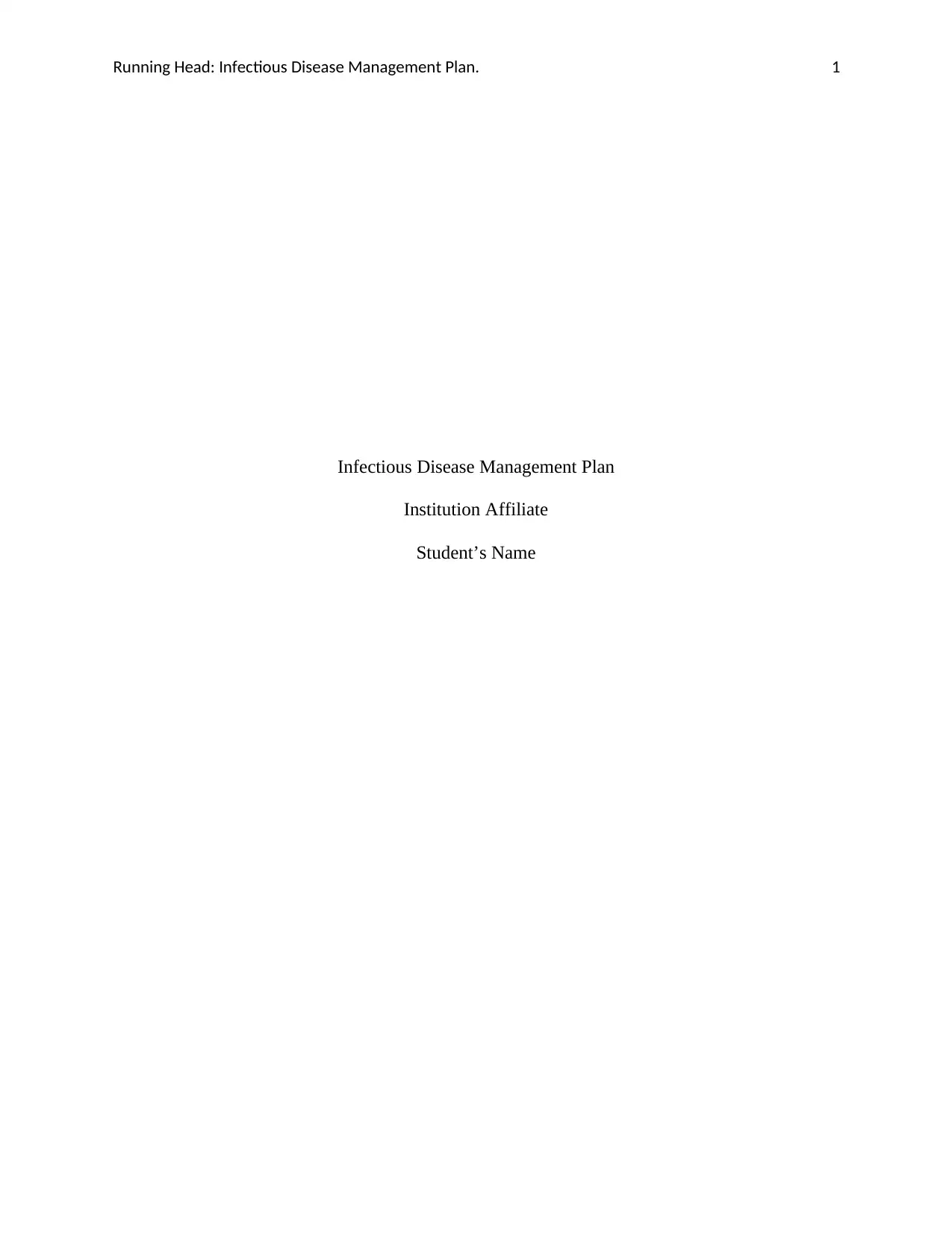
Running Head: Infectious Disease Management Plan. 1
Infectious Disease Management Plan
Institution Affiliate
Student’s Name
Infectious Disease Management Plan
Institution Affiliate
Student’s Name
Paraphrase This Document
Need a fresh take? Get an instant paraphrase of this document with our AI Paraphraser
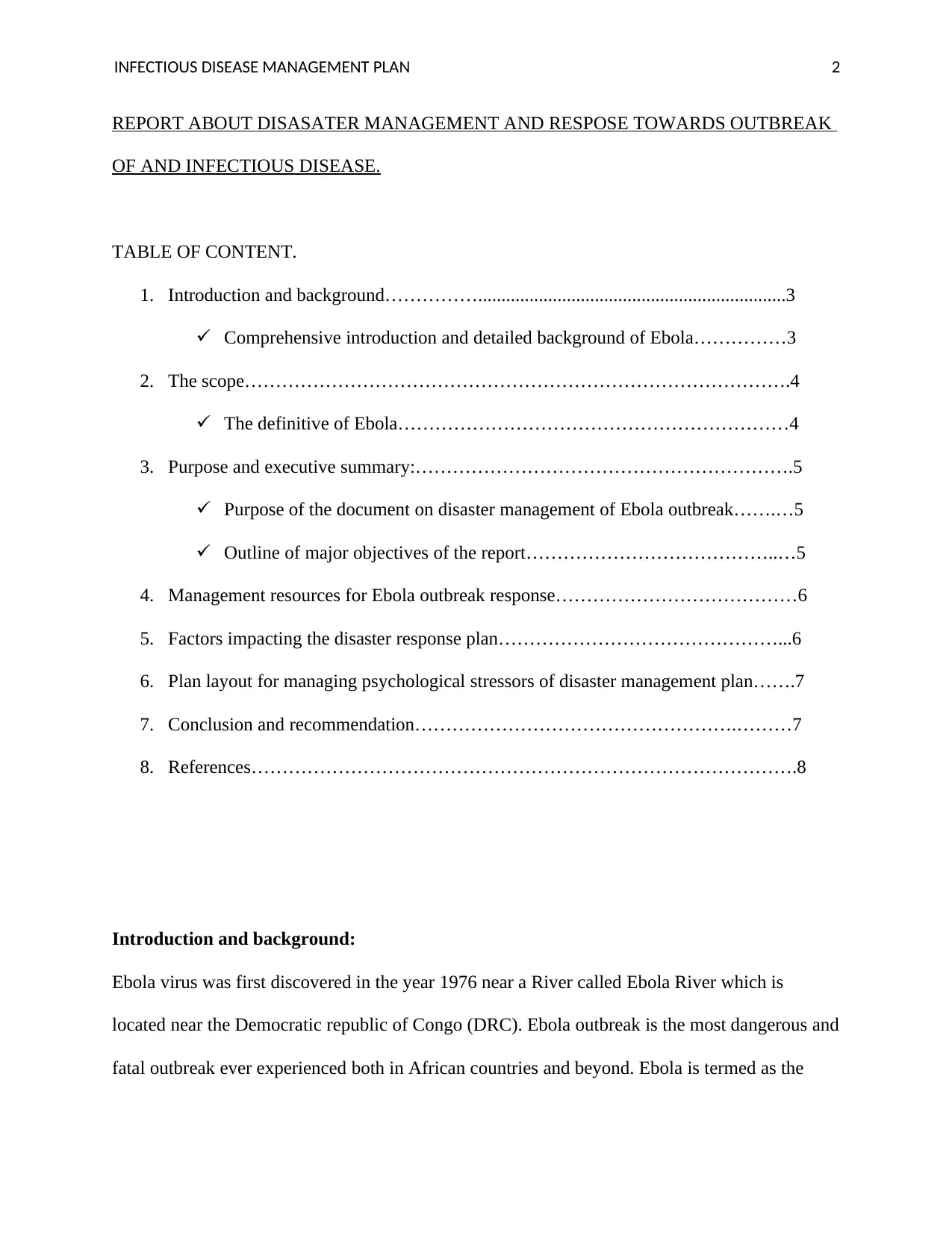
INFECTIOUS DISEASE MANAGEMENT PLAN 2
REPORT ABOUT DISASATER MANAGEMENT AND RESPOSE TOWARDS OUTBREAK
OF AND INFECTIOUS DISEASE.
TABLE OF CONTENT.
1. Introduction and background……………..................................................................3
Comprehensive introduction and detailed background of Ebola……………3
2. The scope…………………………………………………………………………….4
The definitive of Ebola………………………………………………………4
3. Purpose and executive summary:…………………………………………………….5
Purpose of the document on disaster management of Ebola outbreak…….…5
Outline of major objectives of the report…………………………………..…5
4. Management resources for Ebola outbreak response…………………………………6
5. Factors impacting the disaster response plan………………………………………...6
6. Plan layout for managing psychological stressors of disaster management plan…….7
7. Conclusion and recommendation…………………………………………….………7
8. References…………………………………………………………………………….8
Introduction and background:
Ebola virus was first discovered in the year 1976 near a River called Ebola River which is
located near the Democratic republic of Congo (DRC). Ebola outbreak is the most dangerous and
fatal outbreak ever experienced both in African countries and beyond. Ebola is termed as the
REPORT ABOUT DISASATER MANAGEMENT AND RESPOSE TOWARDS OUTBREAK
OF AND INFECTIOUS DISEASE.
TABLE OF CONTENT.
1. Introduction and background……………..................................................................3
Comprehensive introduction and detailed background of Ebola……………3
2. The scope…………………………………………………………………………….4
The definitive of Ebola………………………………………………………4
3. Purpose and executive summary:…………………………………………………….5
Purpose of the document on disaster management of Ebola outbreak…….…5
Outline of major objectives of the report…………………………………..…5
4. Management resources for Ebola outbreak response…………………………………6
5. Factors impacting the disaster response plan………………………………………...6
6. Plan layout for managing psychological stressors of disaster management plan…….7
7. Conclusion and recommendation…………………………………………….………7
8. References…………………………………………………………………………….8
Introduction and background:
Ebola virus was first discovered in the year 1976 near a River called Ebola River which is
located near the Democratic republic of Congo (DRC). Ebola outbreak is the most dangerous and
fatal outbreak ever experienced both in African countries and beyond. Ebola is termed as the
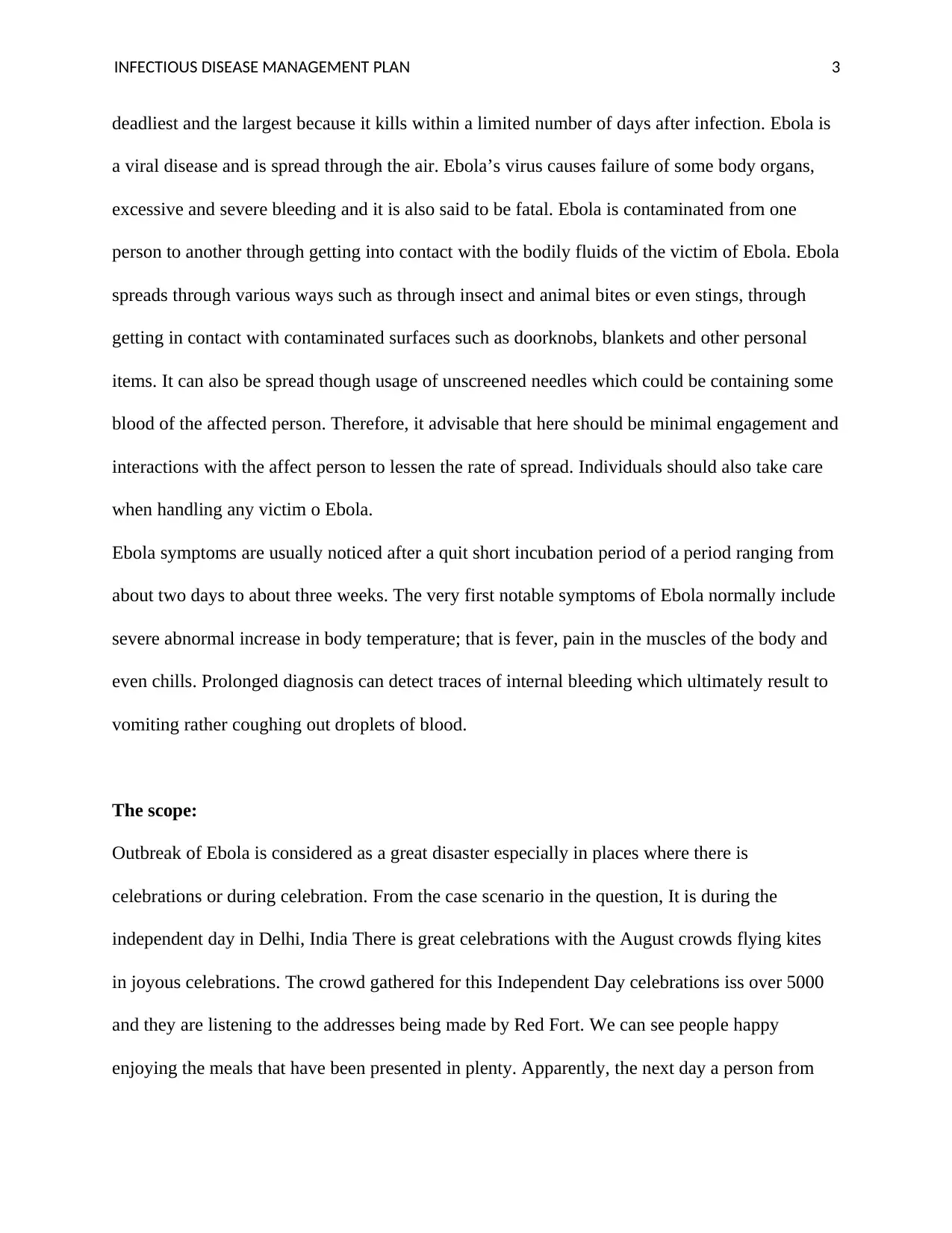
INFECTIOUS DISEASE MANAGEMENT PLAN 3
deadliest and the largest because it kills within a limited number of days after infection. Ebola is
a viral disease and is spread through the air. Ebola’s virus causes failure of some body organs,
excessive and severe bleeding and it is also said to be fatal. Ebola is contaminated from one
person to another through getting into contact with the bodily fluids of the victim of Ebola. Ebola
spreads through various ways such as through insect and animal bites or even stings, through
getting in contact with contaminated surfaces such as doorknobs, blankets and other personal
items. It can also be spread though usage of unscreened needles which could be containing some
blood of the affected person. Therefore, it advisable that here should be minimal engagement and
interactions with the affect person to lessen the rate of spread. Individuals should also take care
when handling any victim o Ebola.
Ebola symptoms are usually noticed after a quit short incubation period of a period ranging from
about two days to about three weeks. The very first notable symptoms of Ebola normally include
severe abnormal increase in body temperature; that is fever, pain in the muscles of the body and
even chills. Prolonged diagnosis can detect traces of internal bleeding which ultimately result to
vomiting rather coughing out droplets of blood.
The scope:
Outbreak of Ebola is considered as a great disaster especially in places where there is
celebrations or during celebration. From the case scenario in the question, It is during the
independent day in Delhi, India There is great celebrations with the August crowds flying kites
in joyous celebrations. The crowd gathered for this Independent Day celebrations iss over 5000
and they are listening to the addresses being made by Red Fort. We can see people happy
enjoying the meals that have been presented in plenty. Apparently, the next day a person from
deadliest and the largest because it kills within a limited number of days after infection. Ebola is
a viral disease and is spread through the air. Ebola’s virus causes failure of some body organs,
excessive and severe bleeding and it is also said to be fatal. Ebola is contaminated from one
person to another through getting into contact with the bodily fluids of the victim of Ebola. Ebola
spreads through various ways such as through insect and animal bites or even stings, through
getting in contact with contaminated surfaces such as doorknobs, blankets and other personal
items. It can also be spread though usage of unscreened needles which could be containing some
blood of the affected person. Therefore, it advisable that here should be minimal engagement and
interactions with the affect person to lessen the rate of spread. Individuals should also take care
when handling any victim o Ebola.
Ebola symptoms are usually noticed after a quit short incubation period of a period ranging from
about two days to about three weeks. The very first notable symptoms of Ebola normally include
severe abnormal increase in body temperature; that is fever, pain in the muscles of the body and
even chills. Prolonged diagnosis can detect traces of internal bleeding which ultimately result to
vomiting rather coughing out droplets of blood.
The scope:
Outbreak of Ebola is considered as a great disaster especially in places where there is
celebrations or during celebration. From the case scenario in the question, It is during the
independent day in Delhi, India There is great celebrations with the August crowds flying kites
in joyous celebrations. The crowd gathered for this Independent Day celebrations iss over 5000
and they are listening to the addresses being made by Red Fort. We can see people happy
enjoying the meals that have been presented in plenty. Apparently, the next day a person from
⊘ This is a preview!⊘
Do you want full access?
Subscribe today to unlock all pages.

Trusted by 1+ million students worldwide
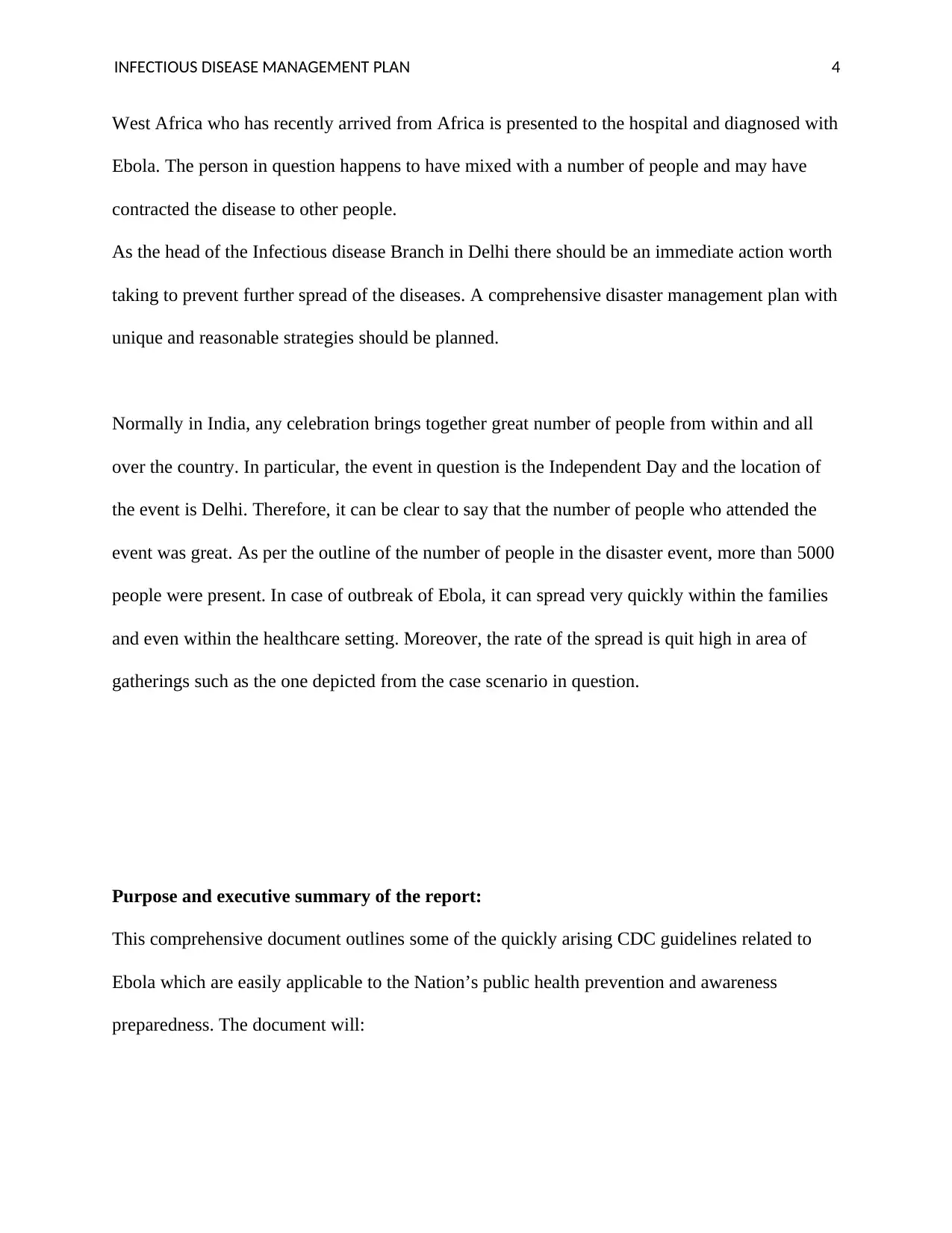
INFECTIOUS DISEASE MANAGEMENT PLAN 4
West Africa who has recently arrived from Africa is presented to the hospital and diagnosed with
Ebola. The person in question happens to have mixed with a number of people and may have
contracted the disease to other people.
As the head of the Infectious disease Branch in Delhi there should be an immediate action worth
taking to prevent further spread of the diseases. A comprehensive disaster management plan with
unique and reasonable strategies should be planned.
Normally in India, any celebration brings together great number of people from within and all
over the country. In particular, the event in question is the Independent Day and the location of
the event is Delhi. Therefore, it can be clear to say that the number of people who attended the
event was great. As per the outline of the number of people in the disaster event, more than 5000
people were present. In case of outbreak of Ebola, it can spread very quickly within the families
and even within the healthcare setting. Moreover, the rate of the spread is quit high in area of
gatherings such as the one depicted from the case scenario in question.
Purpose and executive summary of the report:
This comprehensive document outlines some of the quickly arising CDC guidelines related to
Ebola which are easily applicable to the Nation’s public health prevention and awareness
preparedness. The document will:
West Africa who has recently arrived from Africa is presented to the hospital and diagnosed with
Ebola. The person in question happens to have mixed with a number of people and may have
contracted the disease to other people.
As the head of the Infectious disease Branch in Delhi there should be an immediate action worth
taking to prevent further spread of the diseases. A comprehensive disaster management plan with
unique and reasonable strategies should be planned.
Normally in India, any celebration brings together great number of people from within and all
over the country. In particular, the event in question is the Independent Day and the location of
the event is Delhi. Therefore, it can be clear to say that the number of people who attended the
event was great. As per the outline of the number of people in the disaster event, more than 5000
people were present. In case of outbreak of Ebola, it can spread very quickly within the families
and even within the healthcare setting. Moreover, the rate of the spread is quit high in area of
gatherings such as the one depicted from the case scenario in question.
Purpose and executive summary of the report:
This comprehensive document outlines some of the quickly arising CDC guidelines related to
Ebola which are easily applicable to the Nation’s public health prevention and awareness
preparedness. The document will:
Paraphrase This Document
Need a fresh take? Get an instant paraphrase of this document with our AI Paraphraser
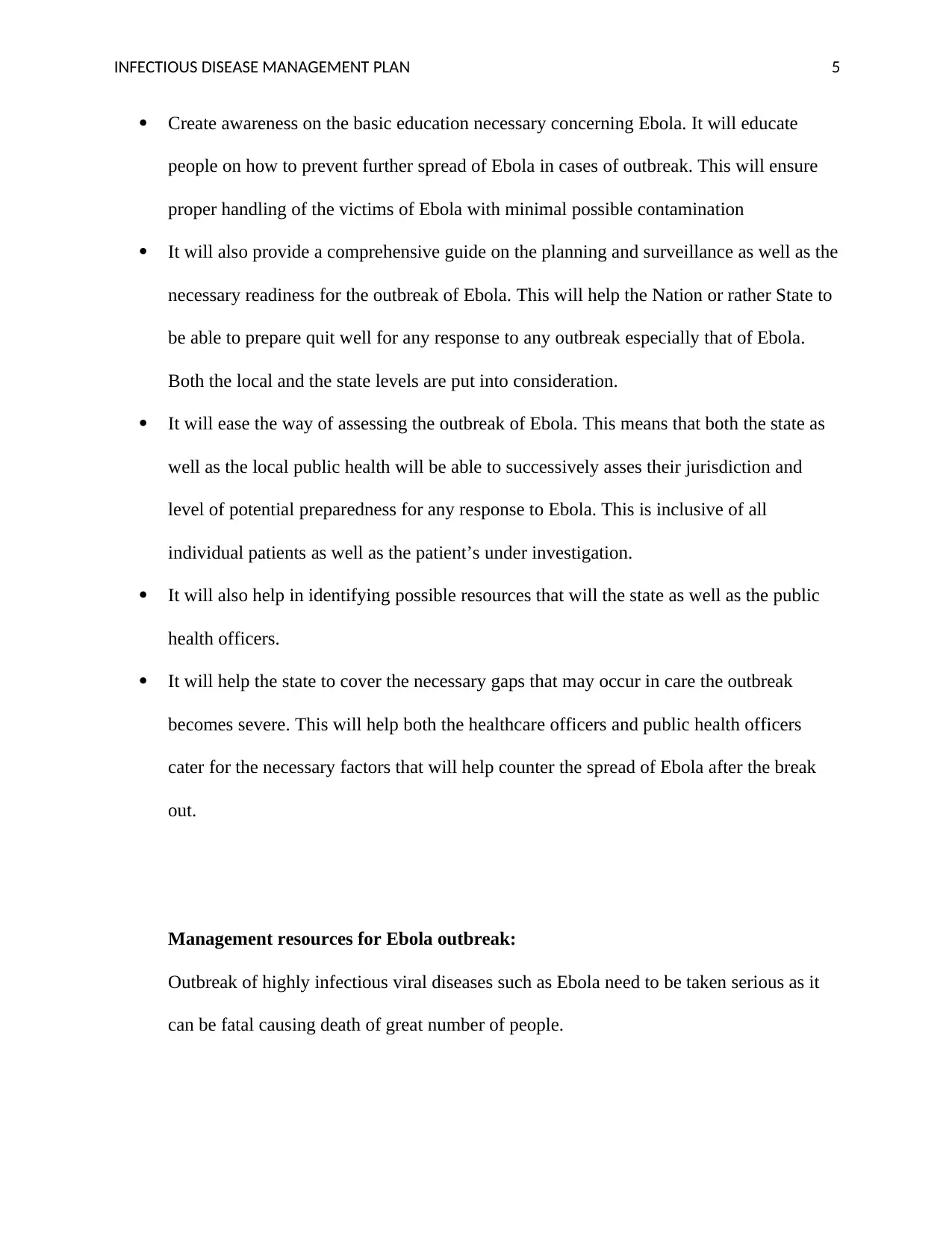
INFECTIOUS DISEASE MANAGEMENT PLAN 5
Create awareness on the basic education necessary concerning Ebola. It will educate
people on how to prevent further spread of Ebola in cases of outbreak. This will ensure
proper handling of the victims of Ebola with minimal possible contamination
It will also provide a comprehensive guide on the planning and surveillance as well as the
necessary readiness for the outbreak of Ebola. This will help the Nation or rather State to
be able to prepare quit well for any response to any outbreak especially that of Ebola.
Both the local and the state levels are put into consideration.
It will ease the way of assessing the outbreak of Ebola. This means that both the state as
well as the local public health will be able to successively asses their jurisdiction and
level of potential preparedness for any response to Ebola. This is inclusive of all
individual patients as well as the patient’s under investigation.
It will also help in identifying possible resources that will the state as well as the public
health officers.
It will help the state to cover the necessary gaps that may occur in care the outbreak
becomes severe. This will help both the healthcare officers and public health officers
cater for the necessary factors that will help counter the spread of Ebola after the break
out.
Management resources for Ebola outbreak:
Outbreak of highly infectious viral diseases such as Ebola need to be taken serious as it
can be fatal causing death of great number of people.
Create awareness on the basic education necessary concerning Ebola. It will educate
people on how to prevent further spread of Ebola in cases of outbreak. This will ensure
proper handling of the victims of Ebola with minimal possible contamination
It will also provide a comprehensive guide on the planning and surveillance as well as the
necessary readiness for the outbreak of Ebola. This will help the Nation or rather State to
be able to prepare quit well for any response to any outbreak especially that of Ebola.
Both the local and the state levels are put into consideration.
It will ease the way of assessing the outbreak of Ebola. This means that both the state as
well as the local public health will be able to successively asses their jurisdiction and
level of potential preparedness for any response to Ebola. This is inclusive of all
individual patients as well as the patient’s under investigation.
It will also help in identifying possible resources that will the state as well as the public
health officers.
It will help the state to cover the necessary gaps that may occur in care the outbreak
becomes severe. This will help both the healthcare officers and public health officers
cater for the necessary factors that will help counter the spread of Ebola after the break
out.
Management resources for Ebola outbreak:
Outbreak of highly infectious viral diseases such as Ebola need to be taken serious as it
can be fatal causing death of great number of people.
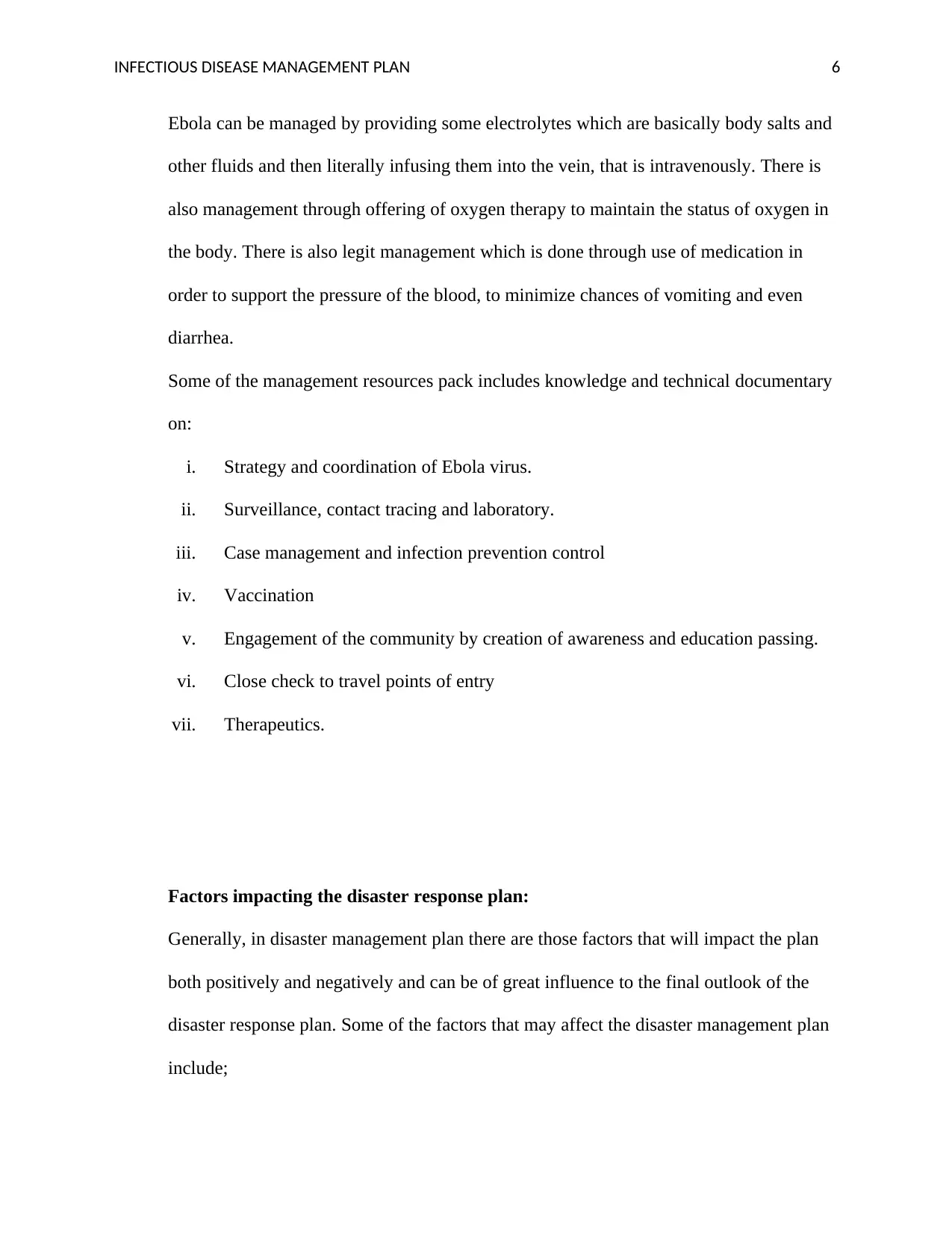
INFECTIOUS DISEASE MANAGEMENT PLAN 6
Ebola can be managed by providing some electrolytes which are basically body salts and
other fluids and then literally infusing them into the vein, that is intravenously. There is
also management through offering of oxygen therapy to maintain the status of oxygen in
the body. There is also legit management which is done through use of medication in
order to support the pressure of the blood, to minimize chances of vomiting and even
diarrhea.
Some of the management resources pack includes knowledge and technical documentary
on:
i. Strategy and coordination of Ebola virus.
ii. Surveillance, contact tracing and laboratory.
iii. Case management and infection prevention control
iv. Vaccination
v. Engagement of the community by creation of awareness and education passing.
vi. Close check to travel points of entry
vii. Therapeutics.
Factors impacting the disaster response plan:
Generally, in disaster management plan there are those factors that will impact the plan
both positively and negatively and can be of great influence to the final outlook of the
disaster response plan. Some of the factors that may affect the disaster management plan
include;
Ebola can be managed by providing some electrolytes which are basically body salts and
other fluids and then literally infusing them into the vein, that is intravenously. There is
also management through offering of oxygen therapy to maintain the status of oxygen in
the body. There is also legit management which is done through use of medication in
order to support the pressure of the blood, to minimize chances of vomiting and even
diarrhea.
Some of the management resources pack includes knowledge and technical documentary
on:
i. Strategy and coordination of Ebola virus.
ii. Surveillance, contact tracing and laboratory.
iii. Case management and infection prevention control
iv. Vaccination
v. Engagement of the community by creation of awareness and education passing.
vi. Close check to travel points of entry
vii. Therapeutics.
Factors impacting the disaster response plan:
Generally, in disaster management plan there are those factors that will impact the plan
both positively and negatively and can be of great influence to the final outlook of the
disaster response plan. Some of the factors that may affect the disaster management plan
include;
⊘ This is a preview!⊘
Do you want full access?
Subscribe today to unlock all pages.

Trusted by 1+ million students worldwide
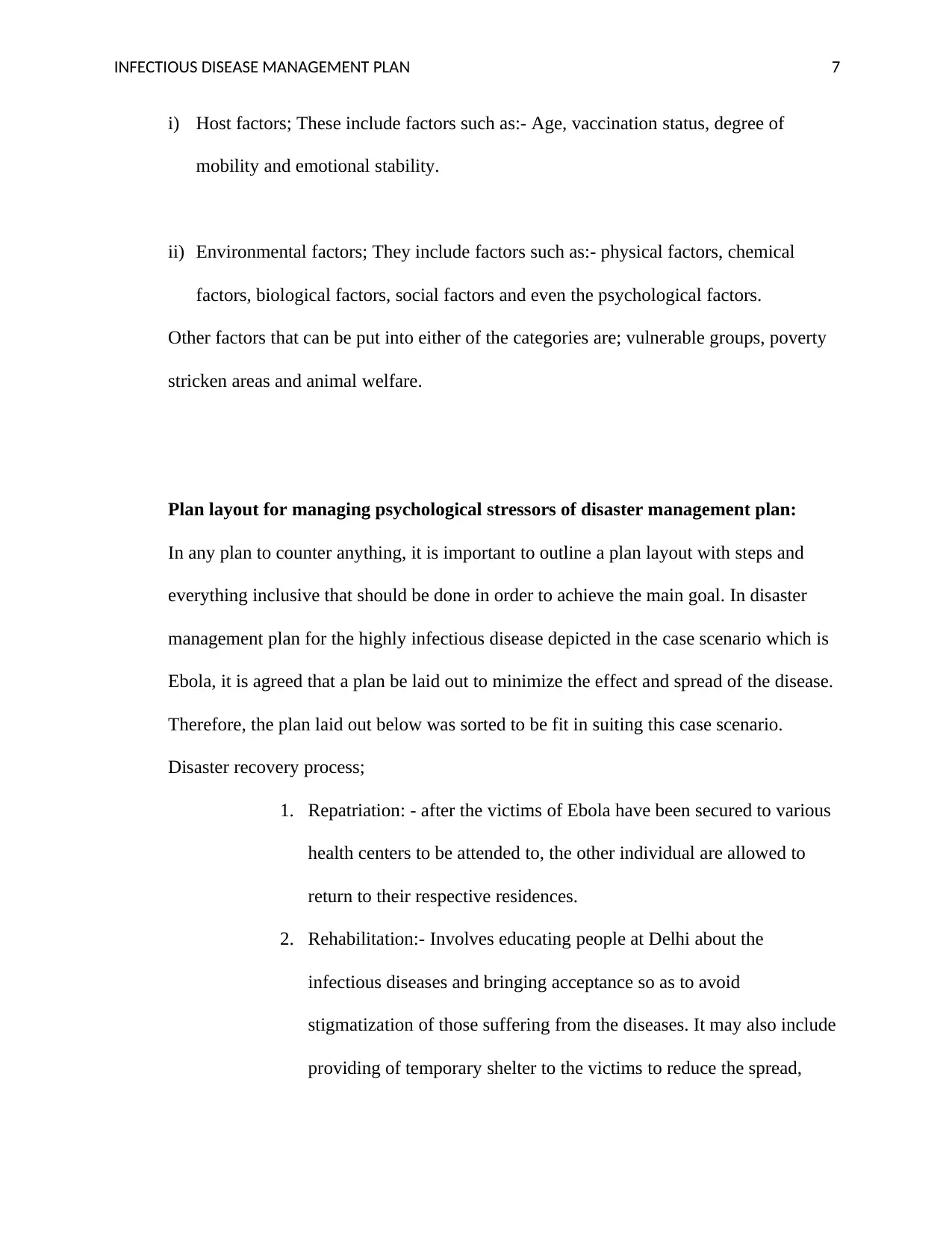
INFECTIOUS DISEASE MANAGEMENT PLAN 7
i) Host factors; These include factors such as:- Age, vaccination status, degree of
mobility and emotional stability.
ii) Environmental factors; They include factors such as:- physical factors, chemical
factors, biological factors, social factors and even the psychological factors.
Other factors that can be put into either of the categories are; vulnerable groups, poverty
stricken areas and animal welfare.
Plan layout for managing psychological stressors of disaster management plan:
In any plan to counter anything, it is important to outline a plan layout with steps and
everything inclusive that should be done in order to achieve the main goal. In disaster
management plan for the highly infectious disease depicted in the case scenario which is
Ebola, it is agreed that a plan be laid out to minimize the effect and spread of the disease.
Therefore, the plan laid out below was sorted to be fit in suiting this case scenario.
Disaster recovery process;
1. Repatriation: - after the victims of Ebola have been secured to various
health centers to be attended to, the other individual are allowed to
return to their respective residences.
2. Rehabilitation:- Involves educating people at Delhi about the
infectious diseases and bringing acceptance so as to avoid
stigmatization of those suffering from the diseases. It may also include
providing of temporary shelter to the victims to reduce the spread,
i) Host factors; These include factors such as:- Age, vaccination status, degree of
mobility and emotional stability.
ii) Environmental factors; They include factors such as:- physical factors, chemical
factors, biological factors, social factors and even the psychological factors.
Other factors that can be put into either of the categories are; vulnerable groups, poverty
stricken areas and animal welfare.
Plan layout for managing psychological stressors of disaster management plan:
In any plan to counter anything, it is important to outline a plan layout with steps and
everything inclusive that should be done in order to achieve the main goal. In disaster
management plan for the highly infectious disease depicted in the case scenario which is
Ebola, it is agreed that a plan be laid out to minimize the effect and spread of the disease.
Therefore, the plan laid out below was sorted to be fit in suiting this case scenario.
Disaster recovery process;
1. Repatriation: - after the victims of Ebola have been secured to various
health centers to be attended to, the other individual are allowed to
return to their respective residences.
2. Rehabilitation:- Involves educating people at Delhi about the
infectious diseases and bringing acceptance so as to avoid
stigmatization of those suffering from the diseases. It may also include
providing of temporary shelter to the victims to reduce the spread,
Paraphrase This Document
Need a fresh take? Get an instant paraphrase of this document with our AI Paraphraser
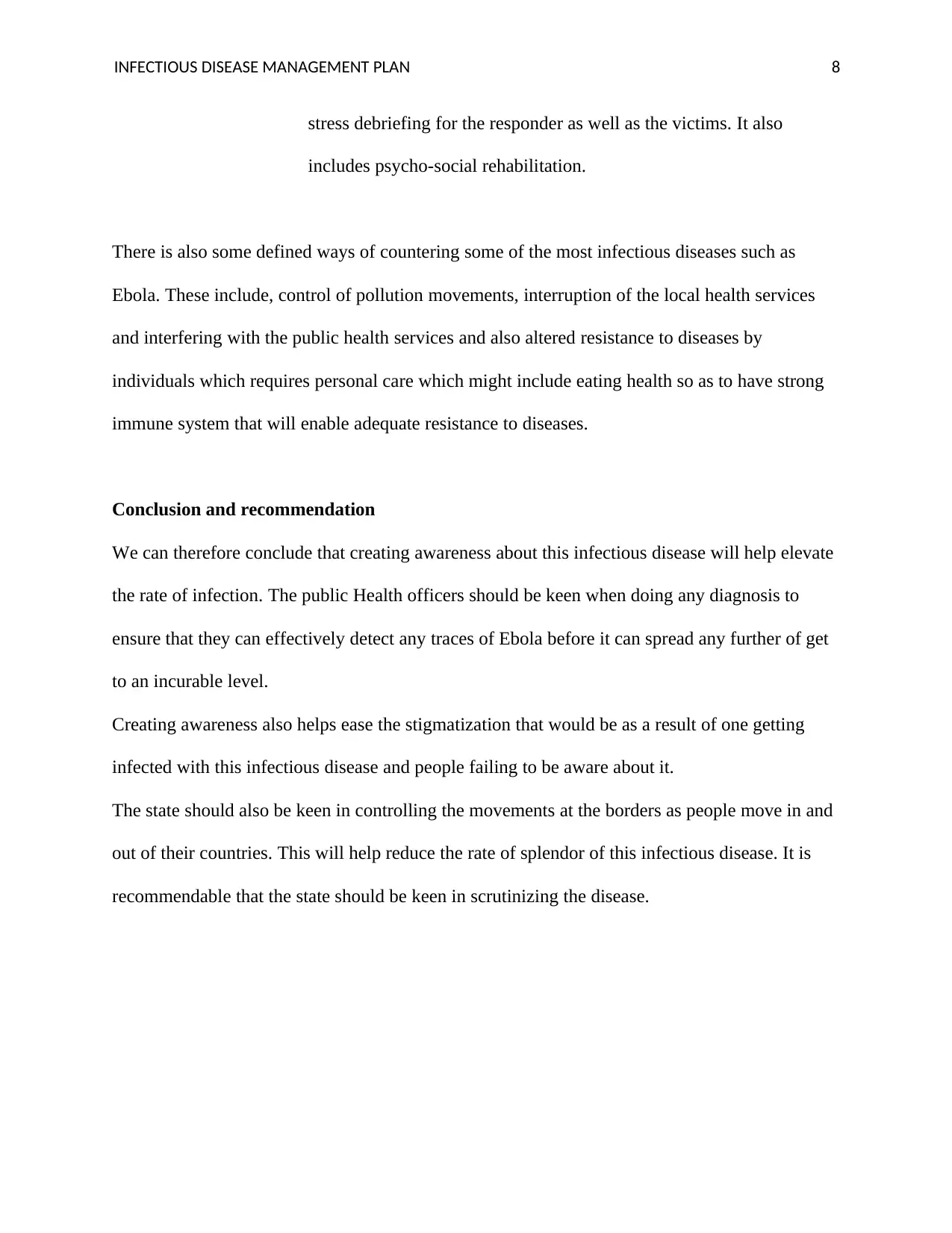
INFECTIOUS DISEASE MANAGEMENT PLAN 8
stress debriefing for the responder as well as the victims. It also
includes psycho-social rehabilitation.
There is also some defined ways of countering some of the most infectious diseases such as
Ebola. These include, control of pollution movements, interruption of the local health services
and interfering with the public health services and also altered resistance to diseases by
individuals which requires personal care which might include eating health so as to have strong
immune system that will enable adequate resistance to diseases.
Conclusion and recommendation
We can therefore conclude that creating awareness about this infectious disease will help elevate
the rate of infection. The public Health officers should be keen when doing any diagnosis to
ensure that they can effectively detect any traces of Ebola before it can spread any further of get
to an incurable level.
Creating awareness also helps ease the stigmatization that would be as a result of one getting
infected with this infectious disease and people failing to be aware about it.
The state should also be keen in controlling the movements at the borders as people move in and
out of their countries. This will help reduce the rate of splendor of this infectious disease. It is
recommendable that the state should be keen in scrutinizing the disease.
stress debriefing for the responder as well as the victims. It also
includes psycho-social rehabilitation.
There is also some defined ways of countering some of the most infectious diseases such as
Ebola. These include, control of pollution movements, interruption of the local health services
and interfering with the public health services and also altered resistance to diseases by
individuals which requires personal care which might include eating health so as to have strong
immune system that will enable adequate resistance to diseases.
Conclusion and recommendation
We can therefore conclude that creating awareness about this infectious disease will help elevate
the rate of infection. The public Health officers should be keen when doing any diagnosis to
ensure that they can effectively detect any traces of Ebola before it can spread any further of get
to an incurable level.
Creating awareness also helps ease the stigmatization that would be as a result of one getting
infected with this infectious disease and people failing to be aware about it.
The state should also be keen in controlling the movements at the borders as people move in and
out of their countries. This will help reduce the rate of splendor of this infectious disease. It is
recommendable that the state should be keen in scrutinizing the disease.
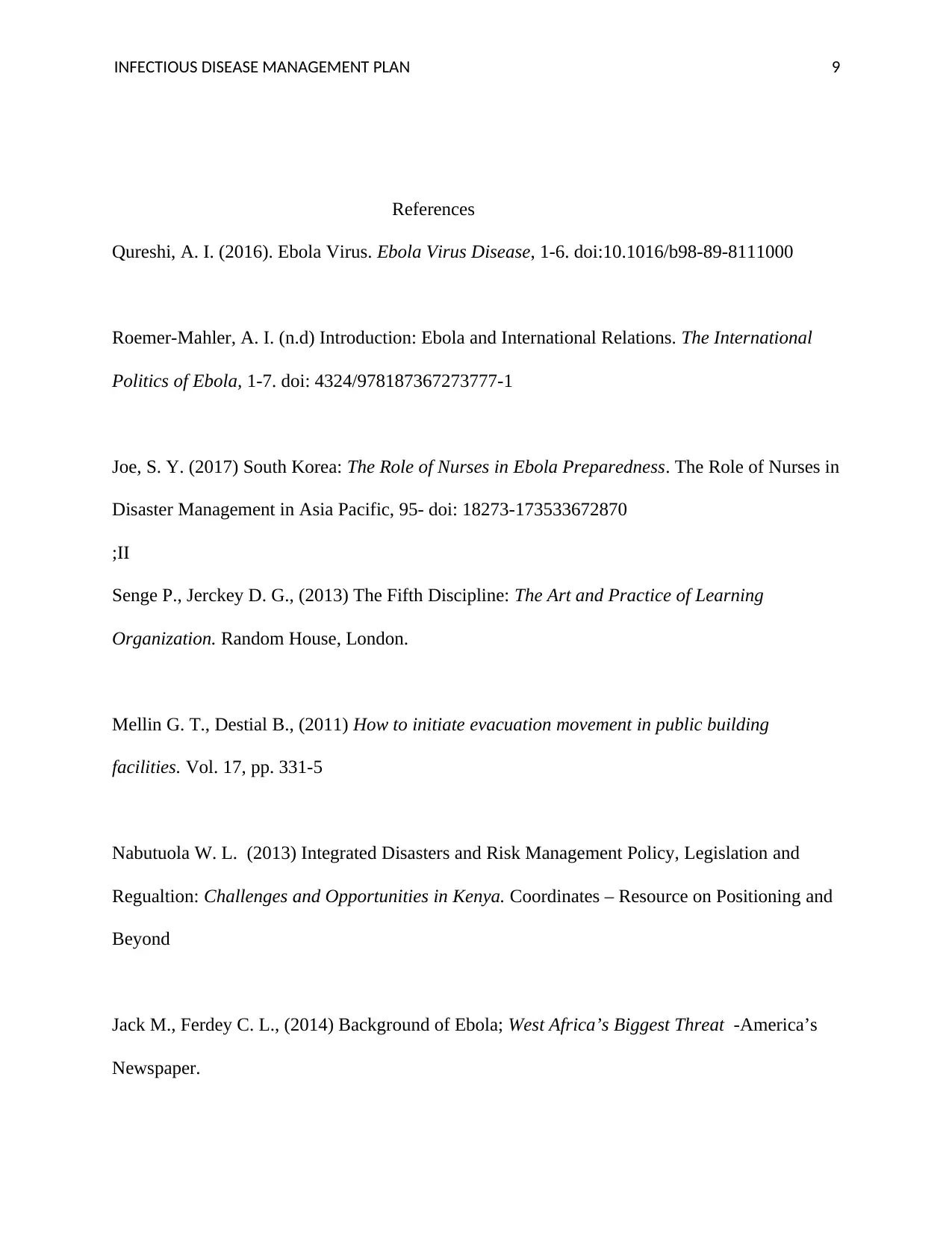
INFECTIOUS DISEASE MANAGEMENT PLAN 9
References
Qureshi, A. I. (2016). Ebola Virus. Ebola Virus Disease, 1-6. doi:10.1016/b98-89-8111000
Roemer-Mahler, A. I. (n.d) Introduction: Ebola and International Relations. The International
Politics of Ebola, 1-7. doi: 4324/978187367273777-1
Joe, S. Y. (2017) South Korea: The Role of Nurses in Ebola Preparedness. The Role of Nurses in
Disaster Management in Asia Pacific, 95- doi: 18273-173533672870
;II
Senge P., Jerckey D. G., (2013) The Fifth Discipline: The Art and Practice of Learning
Organization. Random House, London.
Mellin G. T., Destial B., (2011) How to initiate evacuation movement in public building
facilities. Vol. 17, pp. 331-5
Nabutuola W. L. (2013) Integrated Disasters and Risk Management Policy, Legislation and
Regualtion: Challenges and Opportunities in Kenya. Coordinates – Resource on Positioning and
Beyond
Jack M., Ferdey C. L., (2014) Background of Ebola; West Africa’s Biggest Threat -America’s
Newspaper.
References
Qureshi, A. I. (2016). Ebola Virus. Ebola Virus Disease, 1-6. doi:10.1016/b98-89-8111000
Roemer-Mahler, A. I. (n.d) Introduction: Ebola and International Relations. The International
Politics of Ebola, 1-7. doi: 4324/978187367273777-1
Joe, S. Y. (2017) South Korea: The Role of Nurses in Ebola Preparedness. The Role of Nurses in
Disaster Management in Asia Pacific, 95- doi: 18273-173533672870
;II
Senge P., Jerckey D. G., (2013) The Fifth Discipline: The Art and Practice of Learning
Organization. Random House, London.
Mellin G. T., Destial B., (2011) How to initiate evacuation movement in public building
facilities. Vol. 17, pp. 331-5
Nabutuola W. L. (2013) Integrated Disasters and Risk Management Policy, Legislation and
Regualtion: Challenges and Opportunities in Kenya. Coordinates – Resource on Positioning and
Beyond
Jack M., Ferdey C. L., (2014) Background of Ebola; West Africa’s Biggest Threat -America’s
Newspaper.
⊘ This is a preview!⊘
Do you want full access?
Subscribe today to unlock all pages.

Trusted by 1+ million students worldwide
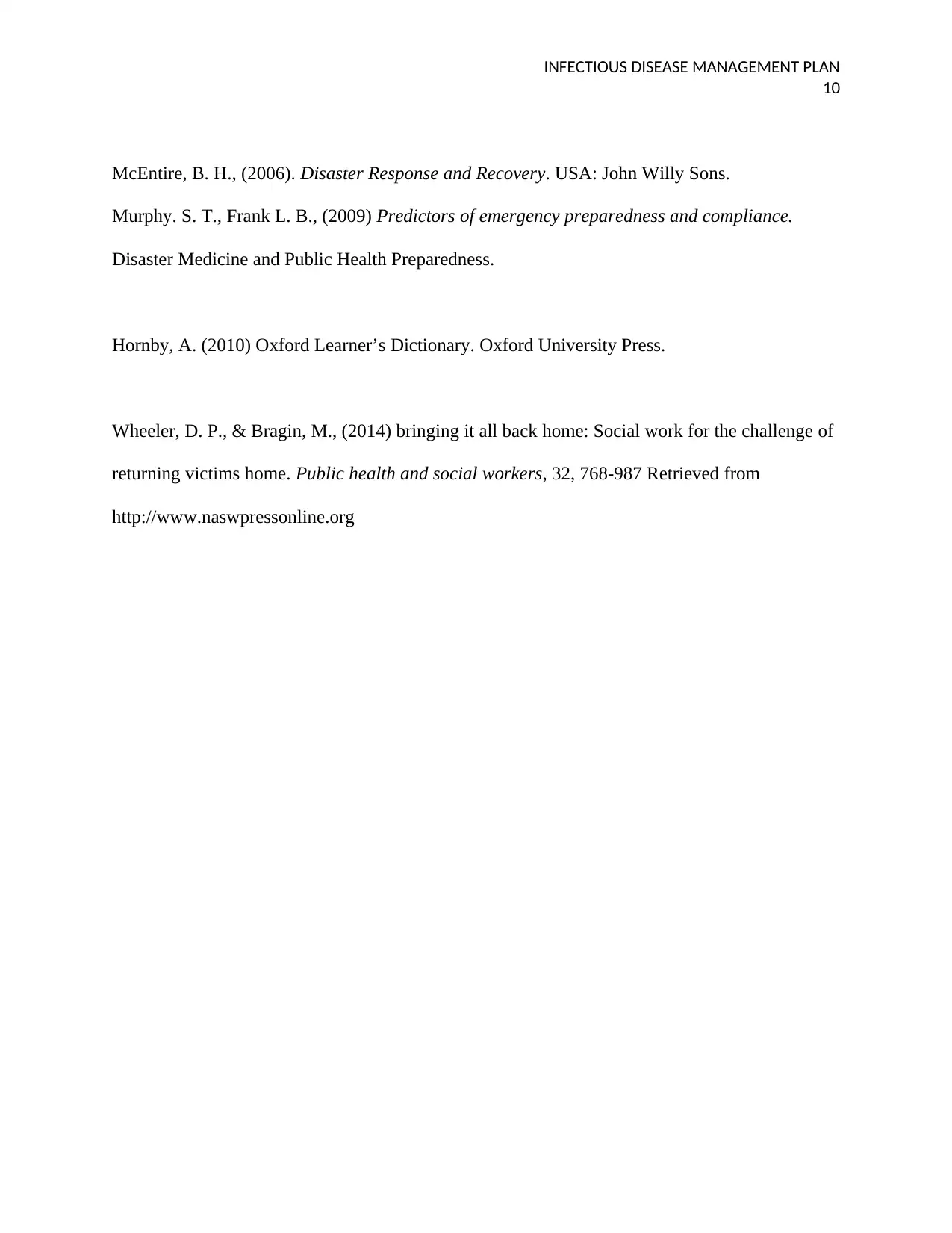
INFECTIOUS DISEASE MANAGEMENT PLAN
10
McEntire, B. H., (2006). Disaster Response and Recovery. USA: John Willy Sons.
Murphy. S. T., Frank L. B., (2009) Predictors of emergency preparedness and compliance.
Disaster Medicine and Public Health Preparedness.
Hornby, A. (2010) Oxford Learner’s Dictionary. Oxford University Press.
Wheeler, D. P., & Bragin, M., (2014) bringing it all back home: Social work for the challenge of
returning victims home. Public health and social workers, 32, 768-987 Retrieved from
http://www.naswpressonline.org
10
McEntire, B. H., (2006). Disaster Response and Recovery. USA: John Willy Sons.
Murphy. S. T., Frank L. B., (2009) Predictors of emergency preparedness and compliance.
Disaster Medicine and Public Health Preparedness.
Hornby, A. (2010) Oxford Learner’s Dictionary. Oxford University Press.
Wheeler, D. P., & Bragin, M., (2014) bringing it all back home: Social work for the challenge of
returning victims home. Public health and social workers, 32, 768-987 Retrieved from
http://www.naswpressonline.org
Paraphrase This Document
Need a fresh take? Get an instant paraphrase of this document with our AI Paraphraser

INFECTIOUS DISEASE MANAGEMENT PLAN
11
11
1 out of 11
Related Documents
Your All-in-One AI-Powered Toolkit for Academic Success.
+13062052269
info@desklib.com
Available 24*7 on WhatsApp / Email
![[object Object]](/_next/static/media/star-bottom.7253800d.svg)
Unlock your academic potential
Copyright © 2020–2025 A2Z Services. All Rights Reserved. Developed and managed by ZUCOL.





